The Amish Blu-ray Movie
HomeThe Amish Blu-ray Movie 
American Experience: The AmishPBS | 2012 | 114 min | Not rated | Feb 28, 2012
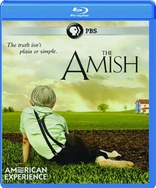
Movie rating
7.1 | / 10 |
Blu-ray rating
| Users | 0.0 | |
| Reviewer | 3.0 | |
| Overall | 3.0 |
Overview
The Amish (2012)
A series showcasing documentaries on American history.
Narrator: Oliver Platt, David Ogden Stiers, Joe Morton, Linda Hunt, Liev SchreiberDirector: Robert Stone (IV), David Grubin, Stephen Ives, Barak Goodman, Ric Burns
| Documentary | 100% |
Specifications
Video
Video codec: MPEG-4 AVC
Video resolution: 1080i
Aspect ratio: 1.78:1
Original aspect ratio: 1.78:1
Audio
English: Dolby Digital 5.1
English: Dolby Digital 2.0
Subtitles
English
Discs
25GB Blu-ray Disc
Single disc (1 BD)
Playback
Region A (B, C untested)
Review
Rating summary
| Movie | 3.0 | |
| Video | 3.5 | |
| Audio | 3.5 | |
| Extras | 1.5 | |
| Overall | 3.0 |
The Amish Blu-ray Movie Review
Needs less English
Reviewed by Brian Orndorf March 7, 2012To imagine the Amish is to picture a gathering of secluded souls working the land together in hand-stitched clothing, the men carrying neckbeards while the apple-cheeked women tend to the children in the background. Because the Amish refuse the intrusion of cameras and recording equipment, it’s been difficult to achieve a full-blooded portrait of the community, forcing filmmakers to turn to outsiders and educators to supply an appreciation of something few are even meant to understand. “The Amish” doesn’t put forward a no-hold-barred look into this remote rural existence, but it does peel away another layer of restriction, inching closer to an intimate look as these hard-working American strangers.
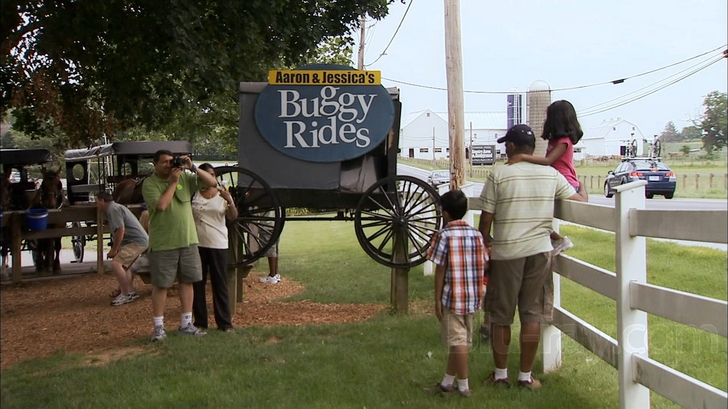
For Hollywood, the Amish have been used as a punchline (1996’s “Kingpin”) or as tool of curiosity to service thriller tropes (1985’s “Witness”). Rarely has anyone, outside of the occasional documentarian, ever attempted a full-scale dissection of the Amish way of life, finding a full appreciation of existence blocked at the property line. Writer/director Dave Belton doesn’t manage to convince members of the community to participate in “The Amish” in front of a camera lens, instead recording a few voices with a microphone, utilizing a verbal perspective to assist in the exploration, with the subjects relaxed enough to investigate their thoughts under the protection of anonymity, thus guaranteeing some sense of honesty.
Taking on the formidable task of understanding Amish life without a methodical visual experience to accompany the narrative strikes me as a little limiting, and the PBS program comes up empty when time arrives to drive home larger psychological and environmental issues, only able to capture community life from afar. Belton is ambitious, but his production often comes across directionless, moving glacially from one bullet point to the next, absent a collection of faces the viewer could cling to as Amish history and daily routines are established. It’s like being asked to describe the caramel center of a Milky Way candy bar by sucking on the chocolate coating. There’s no penetration here beyond audio-based thoughts from nameless individuals, and while their insights are adequate, the information here is hardly illuminating. Try as he might, Belton can’t crack the resolute distance arranged by the Amish, struggling to describe a religious order without a true representative open to share complicated thoughts and feelings. “The Amish” creates a mood of connection but it’s all so frustratingly incomplete, a feeling exacerbated when Belton moves over to those who were actually associated with the community and are now willing to talk about their experiences.
Salome and Levi are two former members of the Amish, both breaking away from their respective families when they felt the call of modern America, with its cell phones, waitress jobs, and general air of freedom. Although Levi is a subdued 20-year-old who seems authentically flummoxed by his place between the Amish and everyday life, he’s a vital personality to meet. Unsure of his future after the loss of his routine, Levi holds to his faith and his construction skills, trusting an answer will appear one day. Salome is a more compelling subject, rejecting the Amish way long ago to experience city life, only to find herself pulled back into the order for a second stint before the young woman walked away for good. While understanding of the ancient Amish way, Salome is honest about her feelings of suppression, fearing a life without a life, endlessly serving others. These viewpoints do more to recognize the Amish mentality and tradition than any of the audio clips, putting a distinct face on a crisis of faith.
“The Amish” is glacial, paced deliberately to match the movement of its subjects. However, Belton is mindful to provide an education on the origin of the Amish and their daily rituals of work and prayer. Again, without vivid examples of on-camera actions, the program is like watching a book on tape, punctuated with thoughts from historians and anthropologists who’ve studied the Pennsylvania and Ohio communities, enthusiastically sharing their thoughts on the Amish resistance of technology, where members fear a modern divide that will distract them from God’s ancient plan. There’s also talk of Ordnung regulations, a list of rules tailored specifically for each Amish community, resulting in inconsistency between farmlands as some orders are more willing to take advantage of contemporary life than others. Most interesting is the discussion of the shunning process, where Amish who’ve lost their faith are essentially ignored by family and friends, coldly blocked out of the intimacy they’ve been raised in. For some, the threat of shunning is enough to keep peace in the communities.
Fighting the textbook page-turning feel of “The Amish” is cinematography by Tim Cragg, who captures heavenly sights of rural spread and activity, emphasizing the seclusion of the Amish as they work around gorgeous displays of nature. It’s a lovely program to study, with striking scenes of mundane work and travel, also providing a crisp contrast between Amish simplicity and the bustling world of local tourists, who flock to stare at the simple, endlessly curious about these quiet folk.
The Amish Blu-ray Movie, Video Quality 

The AVC encoded image (1.78:1 aspect ratio) presentation on "The Amish" does carry a pronounced HD look, with camera limitations easily detected, resulting in some softness and moments of blur. Colors are best served here, popping off deep green farmlands and tacky tourist outfits, with light blues and tasteful reds nicely served here. Detail is largely impressive, best with fabrics and interviewee close-ups, bringing out a pleasing sense of texture to hollow interiors as well. Shadow detail does tend to solidify with low-light sequences (the natural light world of the Amish leaves the cinematography with its hands tied at times), but distances are satisfactorily maintained. The disc does manage to create an evocative feel for the locations, with a healthy HD appearance that's best when lingering on the particulars of this world.
The Amish Blu-ray Movie, Audio Quality 
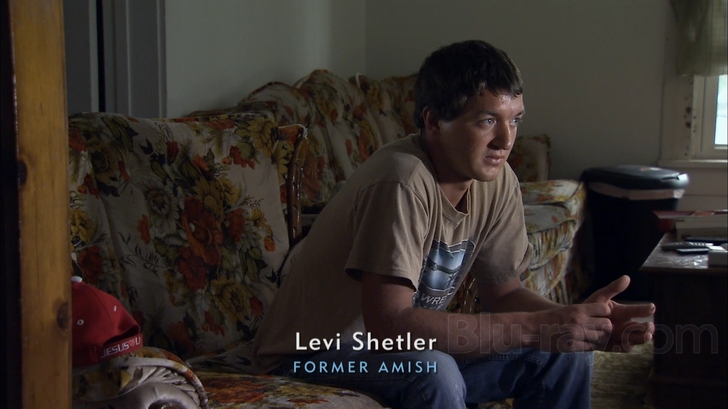
The 5.1 Dolby Digital sound mix doesn't offer many extensive moments of dimensional force, but there's attention here to environmental elements that keeps the track interesting. The surrounds are engaged throughout the presentation, expanding the wind and distant activities, keeping subtle yet effective. Interview audio is held up front, with a good, clean center position that preserves a freshness of voice and clarity of emotion, though nobody here, outside of the scholars, raises their demeanor in any vibrant manner. Scoring is pronounced to capture the rustic mood, carrying the visuals superbly with strong instrumentation and dramatic deployment. Low-end is nonexistent, leaving the mix deliberately delicate, without any noticeable distortion.
The Amish Blu-ray Movie, Special Features and Extras 
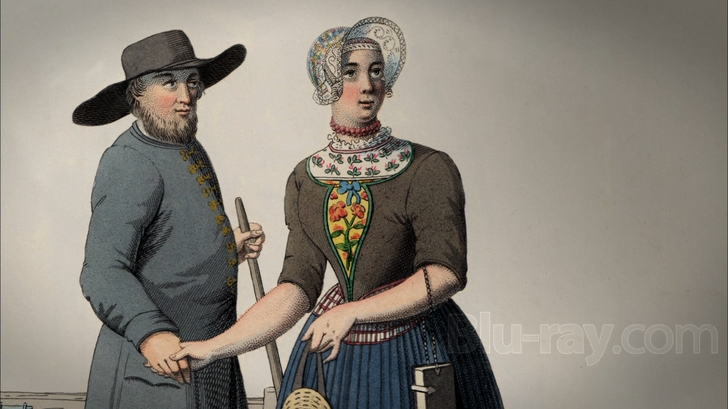
- Behind the Scenes (2:49, HD) talks to producer Mark Samels, writer/director David Belton, and producer Callie T. Wiser, who discuss the challenges of creating a portrait of the Amish without permission to film them. Thoughts on thematic intent are also included.
The Amish Blu-ray Movie, Overall Score and Recommendation 
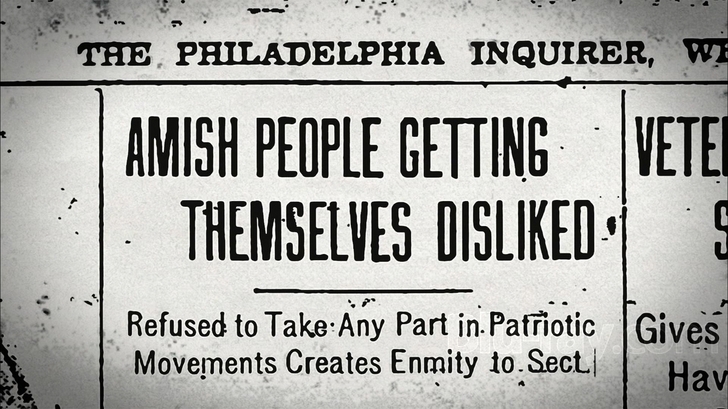
"The Amish" makes a concerted effort to inspect the dark side of life, with asides devoted to the tragic 2006 school shooting in Nickel Mines, Pennsylvania and the history of spousal abuse, a common occurrence in a religious tradition that demands female subservience. While the program creates a feel for education, it rarely provides a profound understanding, kept at arm's length for nearly two hours. "The Amish" volleys between insightful and maddening one too many times, losing its lasting impact to excessive length and an absence of dynamic perspectives.
Other editions
American Experience: Other Seasons

American Experience: Earth Days
2010

American Experience: Into The Deep - America, Whaling & The World
2010

American Experience: Freedom Riders
2011

Clinton
American Experience: Clinton
2012
Similar titles
Similar titles you might also like
(Still not reliable for this title)

Fahrenheit 11/9
2018

RBG
2018

I Am Not Your Negro
2016

Where to Invade Next
2015

Prohibition
2011

Fahrenheit 9/11
2004

Waiting for "Superman"
2010

The Fog of War: Eleven Lessons from the Life of Robert S. McNamara
2003

Hearts of Darkness: A Filmmaker's Apocalypse
1991

Capitalism: A Love Story
2009

Studio 54: The Documentary
2018

An Inconvenient Sequel: Truth to Power
2017

Drunk Stoned Brilliant Dead: The Story of the National Lampoon
2015

Best of Enemies
2015

The Wolfpack
2015

Roger & Me
1989

A Place at the Table
2012

Why We Fight
2005

The Gatekeepers
2012

Enron: The Smartest Guys in the Room
2005